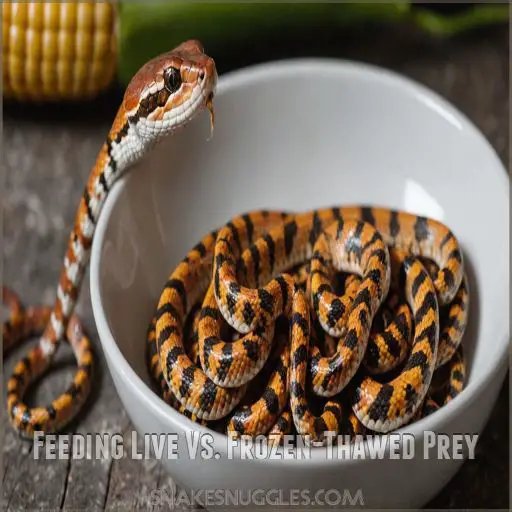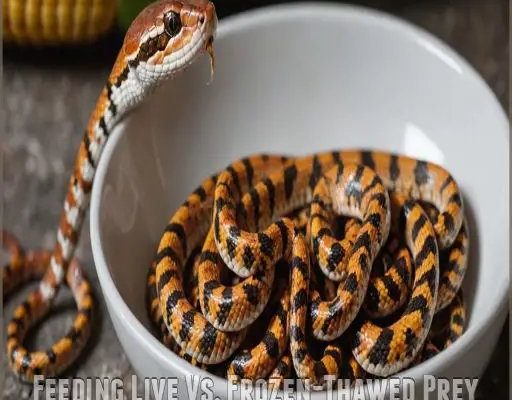
Corn snakes are fascinating creatures. They’re not just your average pet; they come with their own quirks and feeding requirements. If you’re new to the world of reptiles, you might be wondering what would be best for your slithering friend. Should you go for the convenience and safety of frozen prey, or the excitement and stimulation that live prey brings? Let’s dive into the pros and cons of each to help you make the best decision for your corn snake.
The Case for Frozen Prey
Feeding your corn snake frozen prey has become increasingly popular among snake owners. One of the biggest advantages is the convenience factor. When you have a stash of frozen mice or rats in your freezer, you’re ready to feed your snake any time. There’s no need for last-minute grocery runs or worrying if the pet store has your preferred food item in stock.
Another benefit is safety. Frozen prey eliminates the risk of injury to your snake. With live prey, there’s always the potential for the prey to fight back, which can lead to bites or scratches. This is especially concerning if your snake is young or not as experienced at hunting. With frozen prey, you’re ensuring a safer feeding experience for your corn snake.
However, it’s important to note that not all corn snakes might take to frozen prey right away. Some snakes need to adapt to the new feeding method. Gently warming the frozen prey before feeding can make it more appealing. You might find that after a couple of tries, your snake will readily accept the meal.
The Drawbacks of Frozen Prey
While frozen prey has its perks, there are some drawbacks. One of the main issues is that some corn snakes simply prefer the thrill of live prey. These snakes enjoy the chase, and frozen prey can seem lackluster by comparison. If your corn snake refuses frozen food outright, it can lead to stress and frustration for both you and your pet.
Another concern is the preparation involved. Feeding frozen prey requires a bit of planning. You need to defrost the food beforehand, which can take time. If you forget to take it out of the freezer or don’t plan ahead, you might find yourself scrambling to find an alternative.
Additionally, there’s also a chance of nutritional imbalance if the frozen prey is of lower quality. Some commercially available frozen prey can lack the nutrients your snake needs. It’s important to source your frozen food from reputable suppliers that ensure their prey items are healthy and nutritious.
The Appeal of Live Prey
On the flip side, feeding your corn snake live prey can be an exciting experience. For many, watching a snake hunt and consume its meal is a fascinating aspect of snake ownership. The movement of live prey can stimulate your snake’s natural hunting instincts and keep it mentally engaged.
Feeding live prey can also alleviate some concerns about nutritional value. A live mouse or rat is often fresher than frozen alternatives, meaning your snake is getting a meal that’s full of nutrients and energy. If you’re looking to mimic a more natural feeding routine, live prey is often seen as the way to go.
But let’s not overlook the practical side. You can get live prey easily at most pet stores. If you’re in a pinch, you won’t have to wait for anything to thaw. Plus, for snakes that refuse frozen food, live prey can be a great solution to keep them healthy and happy.
The Risks of Live Prey
Despite its appeal, live prey does come with its own set of risks. One of the most significant concerns is potential injury to your snake. Even a small mouse can bite if it feels threatened, and these bites can lead to infections or other health issues. It’s a risk that comes with the territory of live feeding.
There’s also the ethical aspect to consider. Some people worry about the treatment of live prey. It’s essential to purchase from reputable sources that prioritize humane practices. That way, you can feel confident that you’re not contributing to unnecessary suffering.
Moreover, the logistics of keeping live prey can be tricky. If you decide to feed live, you need to ensure you have a proper habitat and care mechanisms in place. Live prey can also create a mess, which means more cleanup after feeding, something that may not be ideal for everyone.
Your Snake’s Preferences Matter
Ultimately, the choice between frozen and live prey should consider your specific corn snake’s preferences and health needs. Some snakes adapt beautifully to frozen food, while others thrive on the excitement of a live meal. Observe your snake’s behavior when you try different feeding options and let their preferences guide your decisions.
If you’re unsure about which route to take, it’s always a good idea to consult with a veterinarian experienced in reptiles. They can provide personalized advice based on your snake’s age, size, and health status.
Balancing Convenience and Safety
Feeding corn snakes should be a balance between convenience and safety. Each method has its pros and cons, and what works for one snake owner might not work for another. Consider your lifestyle, how much time you can dedicate to feeding, and what you feel most comfortable with.
Remember that the goal is to provide the best care for your corn snake. If you choose frozen prey, ensure you’re sourcing high-quality options. If you opt for live prey, stay vigilant about safety and treatment. Whichever method you choose, keep a close eye on your snake’s health and behavior to ensure they’re thriving.
Finding What Works Best for You
So, what’s the final takeaway? Whether you’re leaning toward frozen or live prey, the best option is the one that keeps your corn snake happy, healthy, and well-fed. You might want to try both methods and see how your snake responds. It’s all about figuring out what works best in your unique situation.
In the end, feeding your corn snake is as much about understanding their instincts and needs as it is about what’s most convenient for you. After all, a well-cared-for corn snake leads to a rewarding relationship between you and your pet. So, dive into the world of snake feeding and enjoy the journey!

